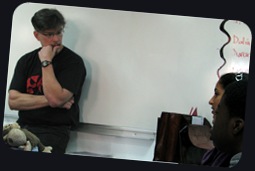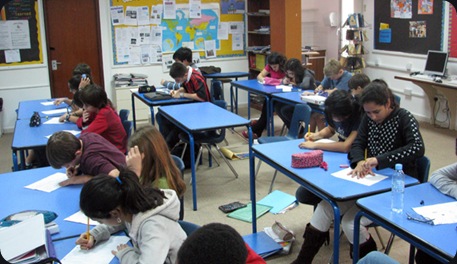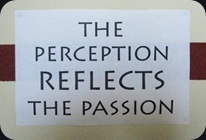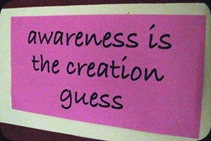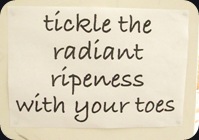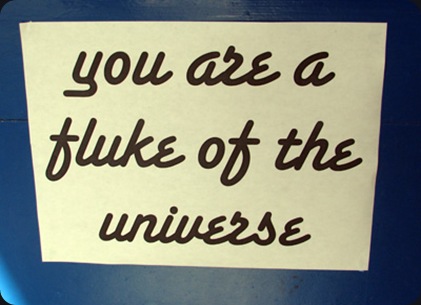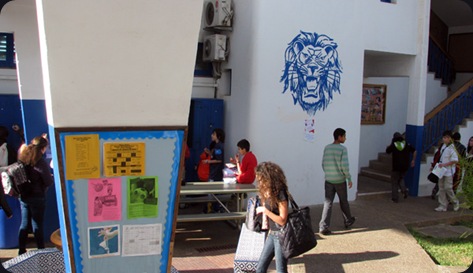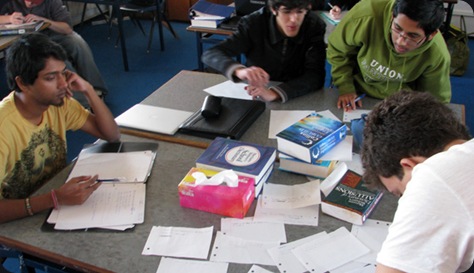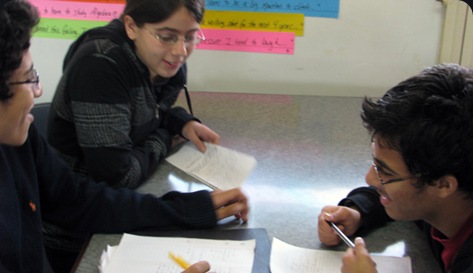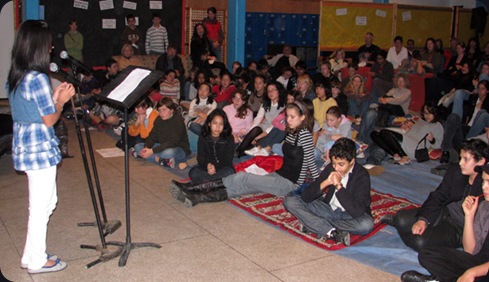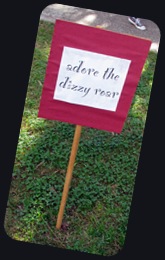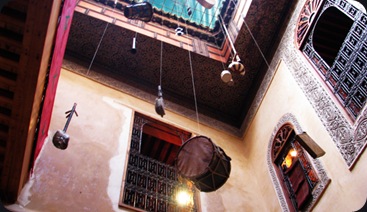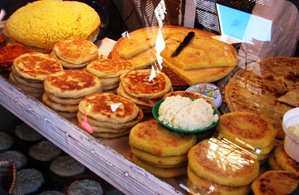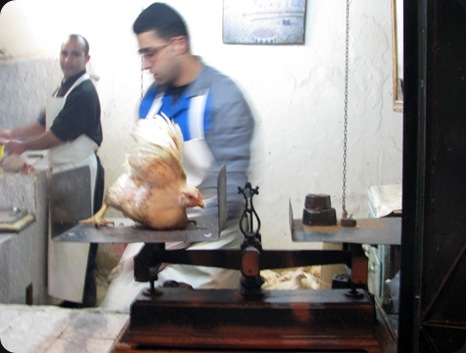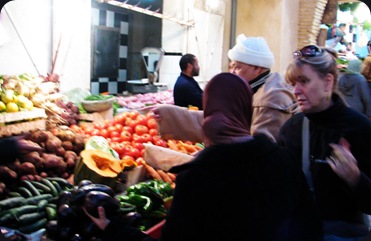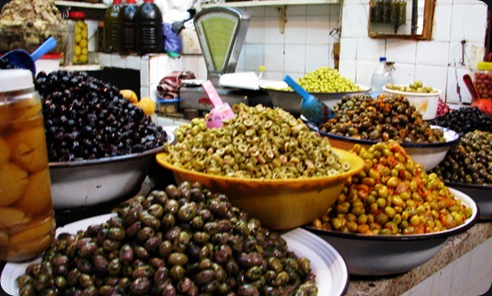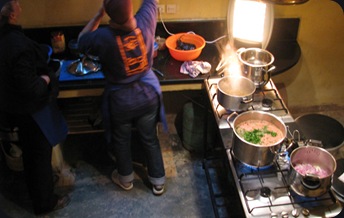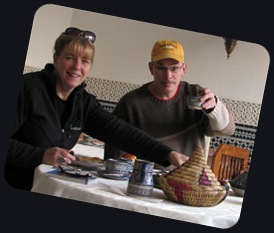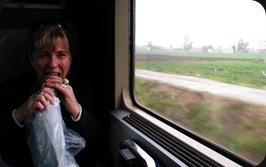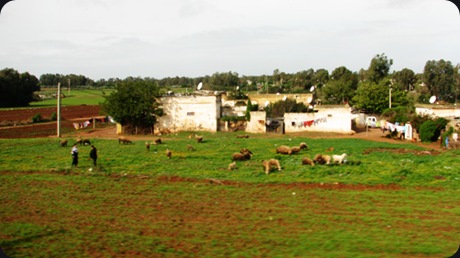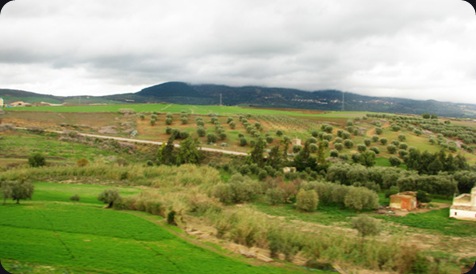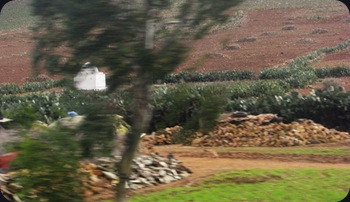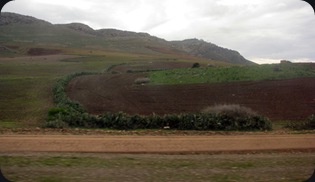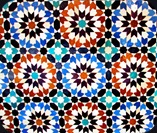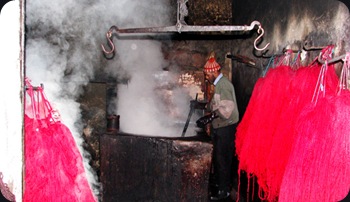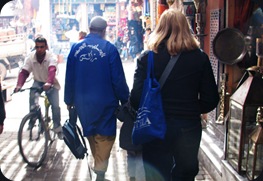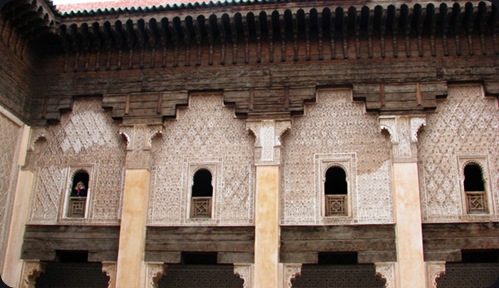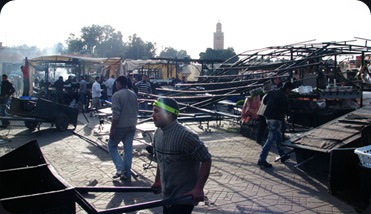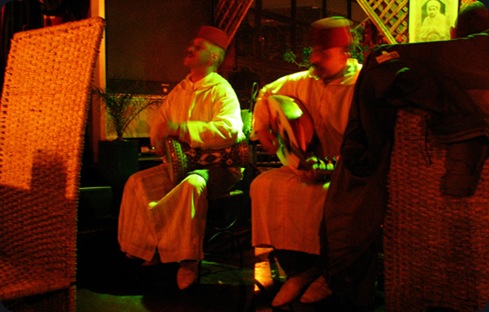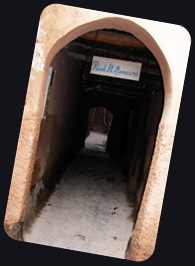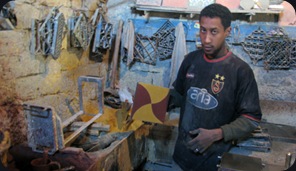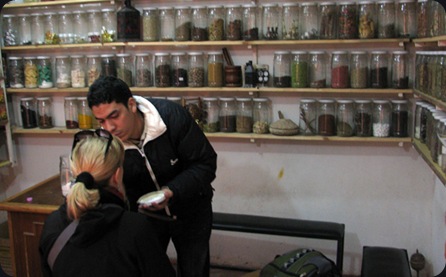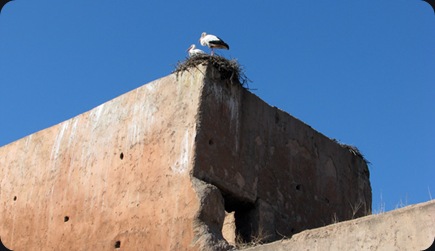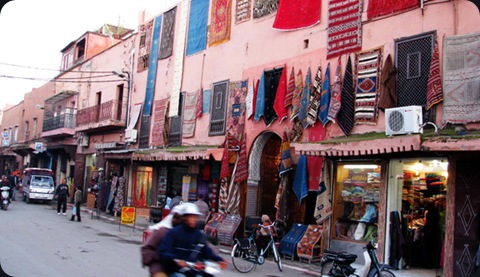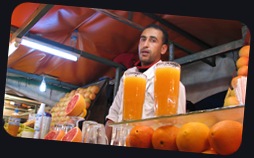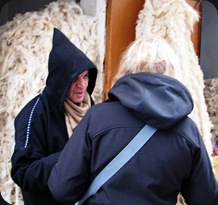 “I am going to take you back into time.” So says Abdullah our guide who shows up five minutes early to lead us through the knotted pathways of Fez. Abdullah is a short cropped gray haired retired teacher a little taller than my shoulder height; he seems to have a glass eye and dressed in a wool hooded jalabia which is worn universally here. He speaks accented but very understandable English. Negotiating one’s way about the city for the first time without a guide would be very difficult if not impossible plus the history provided and the questions answered by Abdullah are worth five times his fee, no wonder he came so highly recommended by the school in Rabat. His shortcuts through the Medina, down passageways almost narrow enough that my shoulders brush both sides of the walls at the same time, are as fascinating as they are time saving.
“I am going to take you back into time.” So says Abdullah our guide who shows up five minutes early to lead us through the knotted pathways of Fez. Abdullah is a short cropped gray haired retired teacher a little taller than my shoulder height; he seems to have a glass eye and dressed in a wool hooded jalabia which is worn universally here. He speaks accented but very understandable English. Negotiating one’s way about the city for the first time without a guide would be very difficult if not impossible plus the history provided and the questions answered by Abdullah are worth five times his fee, no wonder he came so highly recommended by the school in Rabat. His shortcuts through the Medina, down passageways almost narrow enough that my shoulders brush both sides of the walls at the same time, are as fascinating as they are time saving.
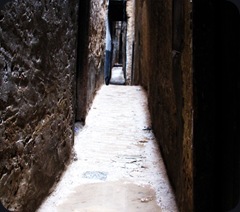 We hop a taxi to drive up to a hill allowing us a panoramic view of the medina; Fez has the largest and most populated medina in the Arab world. Again, a medina is the oldest part of a city, the city within a city, the walled medieval portion. Outside of the walls Fez is a typical modern Arab metropolis of a million residents, inside of the walls 350,000 folks live and work in buildings dating back to the ninth century. The world’s oldest university also resides behind these walls. We climb back into our cab and take a short ride to the king’s palace also overlooking the medina. Morocco is a monarchy and the king has palaces in all the major cities. Abdulla explains the colors of the tiles that mosaic the walls, green standing for the Muslim faith, red standing for sacrifice and blue for the city of Fez.
We hop a taxi to drive up to a hill allowing us a panoramic view of the medina; Fez has the largest and most populated medina in the Arab world. Again, a medina is the oldest part of a city, the city within a city, the walled medieval portion. Outside of the walls Fez is a typical modern Arab metropolis of a million residents, inside of the walls 350,000 folks live and work in buildings dating back to the ninth century. The world’s oldest university also resides behind these walls. We climb back into our cab and take a short ride to the king’s palace also overlooking the medina. Morocco is a monarchy and the king has palaces in all the major cities. Abdulla explains the colors of the tiles that mosaic the walls, green standing for the Muslim faith, red standing for sacrifice and blue for the city of Fez.
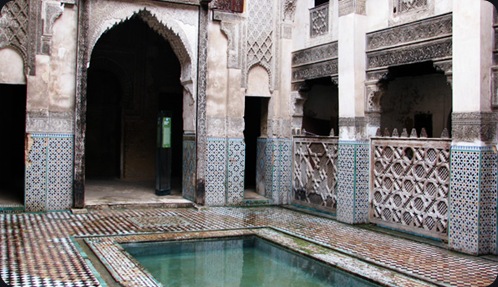 We then enter the new portion of the medina only dating back to the 14th century. This is also the Jewish quarter we are informed. Here balconies look out onto the streets in sharp contrast to most Arab architecture which looks inward. There is, as well, more than a hint of Spanish influence in the structural design of these building. Later when Abdullah informs us we are walking through a very wealth part of the medina we are struck by how plain the outside of the residences look. Just doorways stuck in stone walls, which we are assured open onto beautiful gardens, fountained courtyards and well appointed households.
We then enter the new portion of the medina only dating back to the 14th century. This is also the Jewish quarter we are informed. Here balconies look out onto the streets in sharp contrast to most Arab architecture which looks inward. There is, as well, more than a hint of Spanish influence in the structural design of these building. Later when Abdullah informs us we are walking through a very wealth part of the medina we are struck by how plain the outside of the residences look. Just doorways stuck in stone walls, which we are assured open onto beautiful gardens, fountained courtyards and well appointed households.
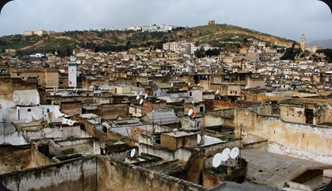 We are staying in a room one of one of these fine houses that has been converted into a riad, a Moroccan version of a bed and breakfast. “Riad means part of paradise. In order to be a true riad it must contain both a garden and a fountain,” Abdullah tells us. He then leads us down a skinny pathway “where no fat person could go.” And we enter the part of the medina constructed in the ninth century – Abdullah is taking us back in time. We pass a mosque – one of 325 situated within the 1.5 square miles encompassed by the walls that form the boundary of the city.
We are staying in a room one of one of these fine houses that has been converted into a riad, a Moroccan version of a bed and breakfast. “Riad means part of paradise. In order to be a true riad it must contain both a garden and a fountain,” Abdullah tells us. He then leads us down a skinny pathway “where no fat person could go.” And we enter the part of the medina constructed in the ninth century – Abdullah is taking us back in time. We pass a mosque – one of 325 situated within the 1.5 square miles encompassed by the walls that form the boundary of the city.
While visiting an ancient medrassa, which is the name for Arabic school, Abdullah informs us that he too is a poet. ‘Listen, I will send you my poem by the e-mail tonight before 7:30 – you must translate it, it is in French. By 7:30, I will send it if you do not get it call me tomorrow, if you get it – no call. In fact Abdullah has been speaking poetry too us all morning. His very understandable but broken English comes in well thought out surges after he has picked the very best words he knows to convey the information that we need to know in order to appreciate his city. After all isn’t that what poetry is concise language? His poem arrived as promised.
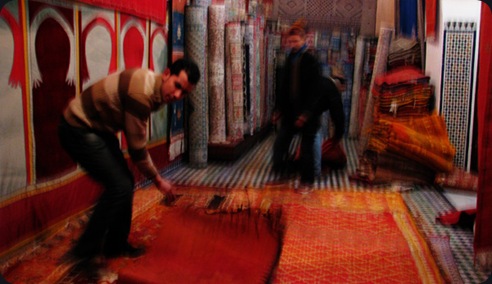 We leave the medrassa, passing a man in a cubbyhole of a shop operating a sewing machine, six or seven other men crowded around no doubt offering him excellent advice, and we make the required visit to a carpet shop. The shop is housed in an enormous house. One can know that the family that once resided here was very important because of the built in seating near the door installed so that the doorkeeper could identify all who knocked and report their arrival to the owner of the house to decide whether these visitors were welcome to enter.
We leave the medrassa, passing a man in a cubbyhole of a shop operating a sewing machine, six or seven other men crowded around no doubt offering him excellent advice, and we make the required visit to a carpet shop. The shop is housed in an enormous house. One can know that the family that once resided here was very important because of the built in seating near the door installed so that the doorkeeper could identify all who knocked and report their arrival to the owner of the house to decide whether these visitors were welcome to enter.
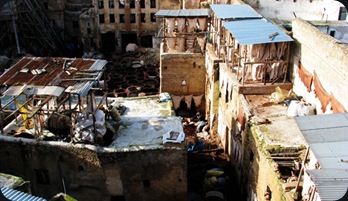 A carpet shop visit is very similar to a trip to a high end auto dealership and follows a grand ritual. First one is offered a tour of the shop, in this case more like a warehouse several stories high. We go out onto the roof of the building and get a good view of the rooftops of the medina and the hills on the horizon. We are then invited into a showroom where we are offered and accept a cup of mint tea and then the show really begins! Wonderful, beautiful, intricate, handmade, Arab and Berber rugs rolled out before our feet. A flurry of assistants shuffle the carpets like cards, the wind produced by the rugs being unfurled blowing our hair back. It becomes overwhelming and we come so close to buying – but somehow in the end we escape with our budget still intact.
A carpet shop visit is very similar to a trip to a high end auto dealership and follows a grand ritual. First one is offered a tour of the shop, in this case more like a warehouse several stories high. We go out onto the roof of the building and get a good view of the rooftops of the medina and the hills on the horizon. We are then invited into a showroom where we are offered and accept a cup of mint tea and then the show really begins! Wonderful, beautiful, intricate, handmade, Arab and Berber rugs rolled out before our feet. A flurry of assistants shuffle the carpets like cards, the wind produced by the rugs being unfurled blowing our hair back. It becomes overwhelming and we come so close to buying – but somehow in the end we escape with our budget still intact.
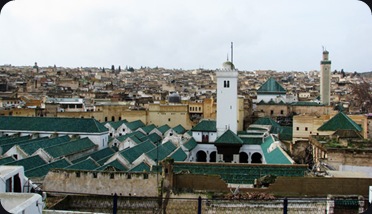 We are then dropped off at a restaurant for lunch and Abdullah disappears into the medina. The restaurant is empty when we first arrive but slowly and surely other guides drop off their clients and the place begins bustling. I have the chicken couscous and Sara a vegetable tagine. The food is served in an elegant fashion but is a little bland compared to the fare that we have been sampling on the streets – no doubt muted for the tourist’s palette.
We are then dropped off at a restaurant for lunch and Abdullah disappears into the medina. The restaurant is empty when we first arrive but slowly and surely other guides drop off their clients and the place begins bustling. I have the chicken couscous and Sara a vegetable tagine. The food is served in an elegant fashion but is a little bland compared to the fare that we have been sampling on the streets – no doubt muted for the tourist’s palette.
Our tour ends with a trip to a leather tannery where we see the amazing process that turns animal hides into leather. We look down from the roof of the tannery shop onto the massive courtyard where he work is performed. Goat, cow, camel and sheepskin are piled all around dozens of different colored earthen pools – a wooden barrel fifteen feet in diameter slowly turns like a water wheel in a mill – the freshly tanned skins inside for washing. Our guide explains the process, the dying, and curing of the hides. All dyes being natural, saffron for yellow, indigo for blues a certain flower for orange etc etc. We do not escape this shop without making a couple buys, a new briefcase for me and a snazzy morocco red jacket for Sara.
All in all this day can only be described as magical. Now, the day ends with another surprise and this story is still developing – but it involves a pair of Papillion dogs, a documentary film maker from New York City, and lost luggage – I’ll let you know how it turns out.

 Speaking no evil is a pretty easy thing to do when you’re talking about the students and the staff at the American Community School in Abu Dhabi. I’ve just finished a week working with the middle school kids and I cannot remember a residency that went smoother. Dianne and Steve, the two librarians responsible for the visit, had a schedule set for me that clicked on every cylinder like the high tech sports cars that prowl the streets of this busy bustling and growing city.
Speaking no evil is a pretty easy thing to do when you’re talking about the students and the staff at the American Community School in Abu Dhabi. I’ve just finished a week working with the middle school kids and I cannot remember a residency that went smoother. Dianne and Steve, the two librarians responsible for the visit, had a schedule set for me that clicked on every cylinder like the high tech sports cars that prowl the streets of this busy bustling and growing city.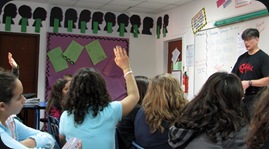 We talked metaphor, we talked memoir, we talked vocabulary and editing and in one class we even talked about zombies! In the meantime Sara and I were well fed and watered enjoying a traditional Arab dinner sans table or chairs, marched up and down the Corniche, visited “The Club” and became intimate friends with a rather kooky cat named Slushie.
We talked metaphor, we talked memoir, we talked vocabulary and editing and in one class we even talked about zombies! In the meantime Sara and I were well fed and watered enjoying a traditional Arab dinner sans table or chairs, marched up and down the Corniche, visited “The Club” and became intimate friends with a rather kooky cat named Slushie.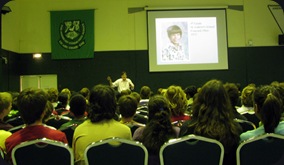 Everywhere you look in this town there are buildings going up, cranes erecting another and another across the skyline. The place wafts the aroma of investment and dividends. My first day in the school (Sunday – the school week runs Sunday through Thursday here) I should have had a premonition that this was going to be a fruitful visit. I put a Dirham coin into a vending machine to buy a bottle of water and not only received my selection, but FIVE more Dirhams. That’s how the whole week went – no matter how much I gave to the kids and their teachers I always ended up ahead of the game.
Everywhere you look in this town there are buildings going up, cranes erecting another and another across the skyline. The place wafts the aroma of investment and dividends. My first day in the school (Sunday – the school week runs Sunday through Thursday here) I should have had a premonition that this was going to be a fruitful visit. I put a Dirham coin into a vending machine to buy a bottle of water and not only received my selection, but FIVE more Dirhams. That’s how the whole week went – no matter how much I gave to the kids and their teachers I always ended up ahead of the game.
